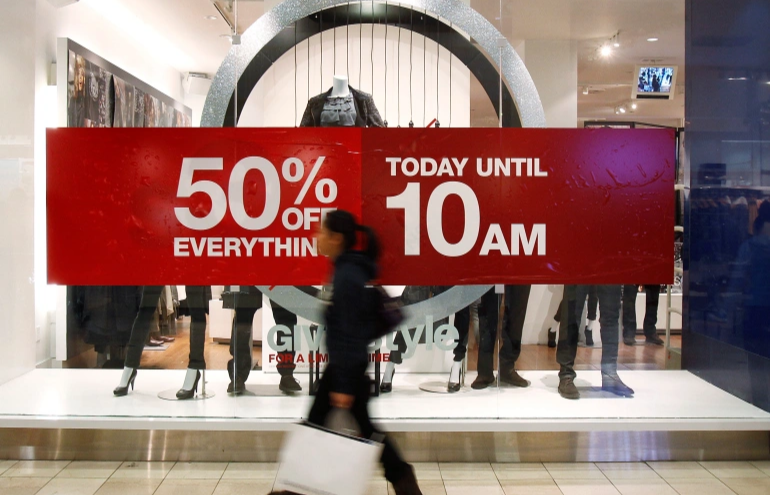
A woman walks by a store's discount advertisement inside the Roosevelt Field Mall in Garden City, New York
Growth in consumer spending, which accounts for more than two-thirds of United States economic activity, slowed [File: Shannon Stapleton/Reuters]
New York, October 28 (RHC)-- U.S. economic growth rebounded strongly in the third quarter amid a shrinking trade deficit, but that overstates the economy’s health as domestic demand was the weakest in two years because of the Federal Reserve’s aggressive interest rate hikes.
The Commerce Department’s advance third-quarter gross domestic product report on Thursday also showed residential investment contracting for a sixth straight quarter as the housing market buckles under the weight of surging mortgage rates. While overall inflation slowed substantially from the second quarter, price pressures continued to bubble.
Still, the rebound in growth after two straight quarterly declines in gross domestic product (GDP) was further evidence that the economy was not in a recession, though the risks of a downturn have increased as the Fed doubles down on rate hikes to battle the fastest-rising inflation in 40 years.
“Despite the shiny headline number, a look under the hood shows a much grimmer picture of the US economy, one that is clearly losing steam,” said Sal Guatieri, a senior economist at BMO Capital Markets in Toronto. “With the full effect of past and future Fed rate hikes still to be felt, the economy appears poised for a modest downturn in the first half of next year.”
GDP increased at a 2.6 percent annualized rate last quarter after contracting at a 0.6 percent pace in the second quarter. Economists polled by Reuters had forecast GDP growth rebounding at a 2.4 percent rate. Estimates ranged from as low as a 0.8 percent rate to as high as a 3.7 percent pace.
The trade deficit narrowed sharply in part as slowing demand curbed the import bill. Exports also increased for much of the quarter. The smaller trade gap added 2.77 percentage points to GDP growth, the most since the third quarter of 1980.
Final sales to private domestic purchasers, which exclude trade, inventories and government spending, edged up at a 0.1 percent rate, a sign that higher borrowing costs were starting to erode demand. That was the slowest rise in this measure of domestic demand since the second quarter of 2020 and followed a 0.5 percent rate increase in the second quarter.
With an eye on the upcoming midterm elections next month, U.S. President Joe Biden in a statement said “today we got further evidence that our economic recovery is continuing to power forward,” adding “Congressional Republicans have a very different agenda – one that would drive up inflation and add to the deficit by cutting taxes for the wealthiest Americans and large corporations.”
Thursday’s data will likely have little impact on monetary policy, though Fed officials could draw some comfort from the ebbing demand. September personal consumption expenditures price data and third-quarter labor cost numbers due on Friday could carry more weight ahead of the Fed’s November 1-2 policy meeting.
The Fed, which is the U.S. central bank, has raised its benchmark overnight interest rate from near zero in March to the current range of 3 percent to 3.25 percent, the swiftest pace of policy tightening in a generation or more.

